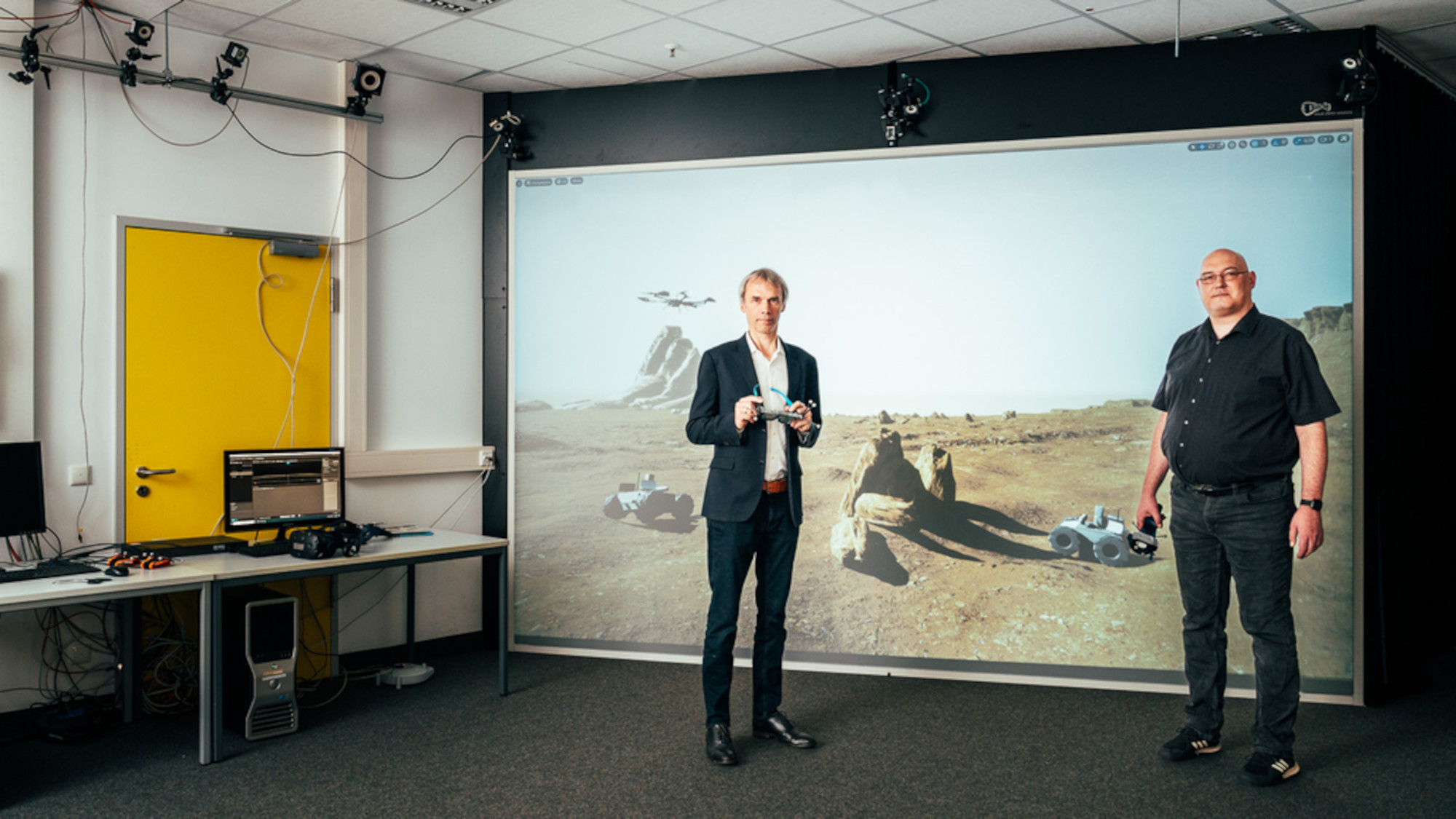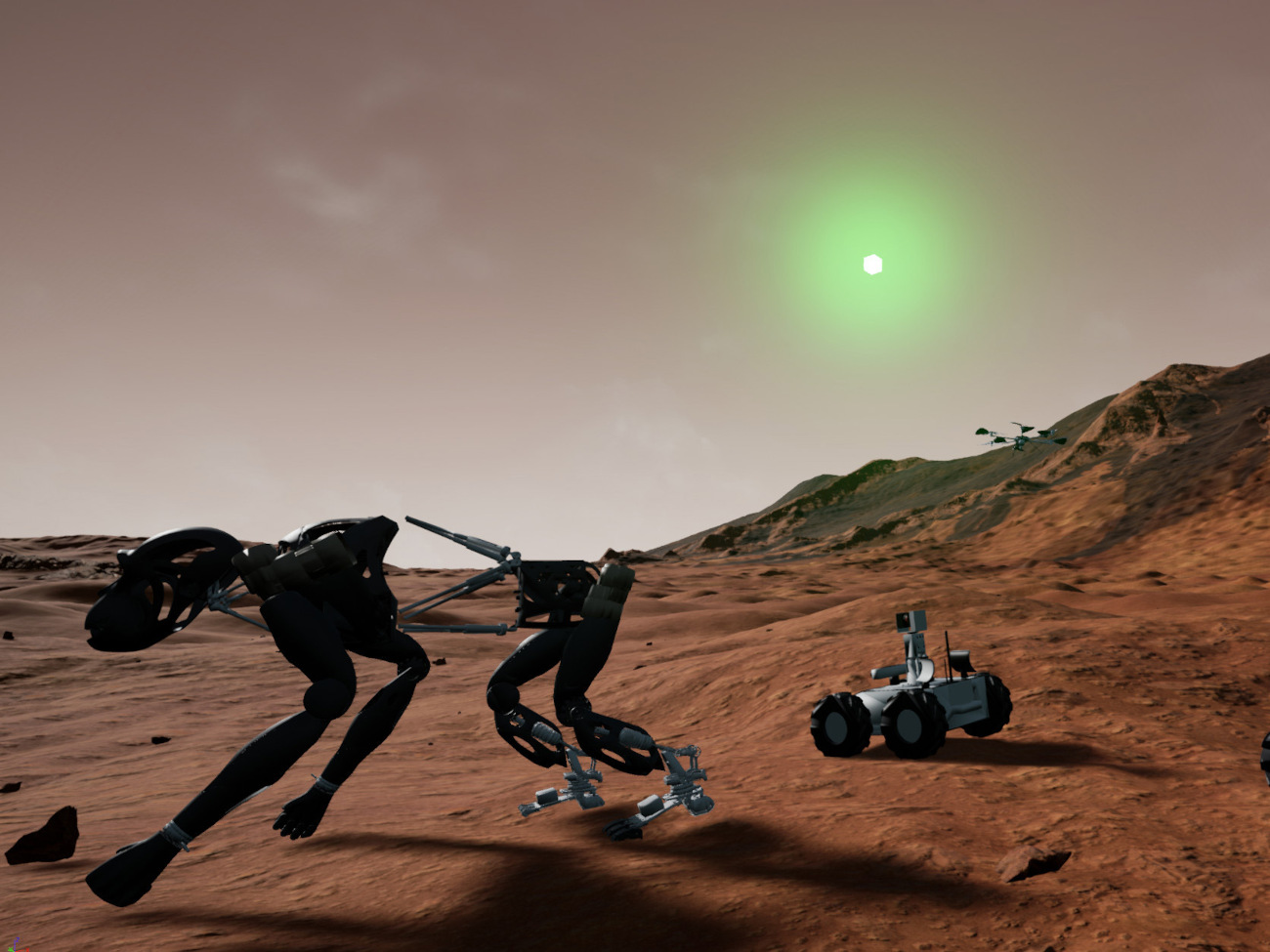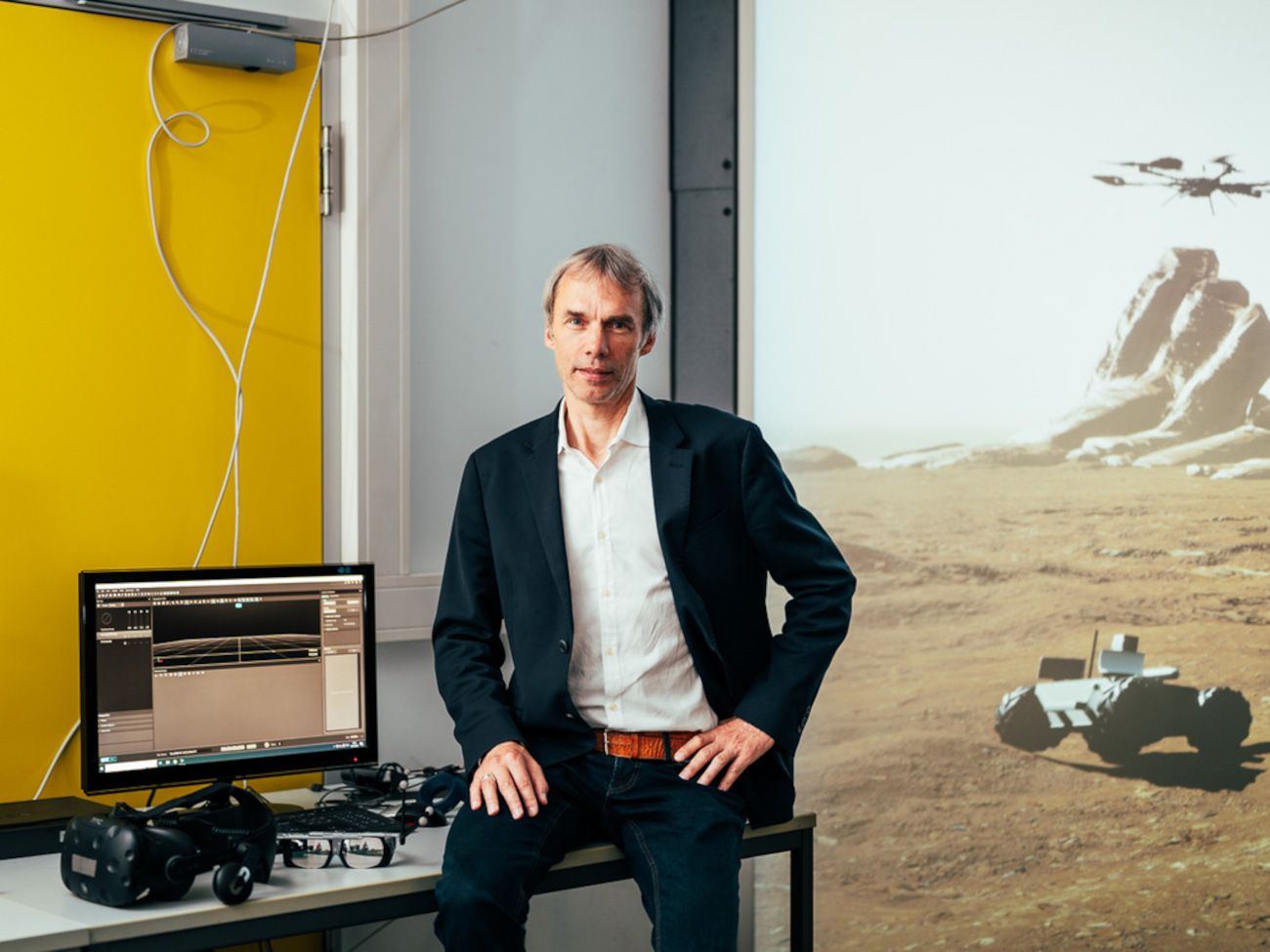
© Lukas Klose / Universität Bremen
Preparing for Mars Exploration
Training Robots in Virtual Reality for their Mission
Did life exist on planet Mars back in the day when the ice there was still water? Three working groups at the University of Bremen are currently collaborating with partners nationwide to develop technologies that will enable them to answer this and other research questions. Key component is the creation of a robot swarm that will be able to explore the rugged landscape of the Martian canyons autonomously.
Water is a key factor for the emergence of life – not just on Earth, but also on other planets. Billions of years ago, the surface of Mars was covered with entire oceans and, in addition, had organic molecules. If life evolved from these oceans, traces of it may still be hidden today in the ice beneath the Martian surface. Such traces would most likely be found in the deeper rock layers, which are only accessible in the rugged valleys of the planet. An autonomous robot swarm is to set off in search for these remnants – and scientists from University of Bremen play a key role in this project.
In order to explore the difficult terrain, robots with different abilities such as running, climbing, or flying need to cooperate. In addition, the robots must be able to transport high payloads and be supplied with energy. The VaMEx (“Valles Marineris Explorer”) initiative, funded by the German Federal Ministry for Economic Affairs and Climate Protection (BMWK), enables a collaboration between different robotic systems. In addition to the University of Bremen, several other partners are involved in the current VaMEx-3 phase, including the German Aerospace Center (DLR) and the DFKI Robotics Innovation Center in Bremen.
Realistic Martian Landscape in Virtual Reality
Developing a collaborating swarm of robots with different operating systems would already be in itself a challenging task for use on Earth, but the destination Mars increases the complications even further. A flight from Earth takes around six to eight months, provided the two orbits align favorably. Because of the long and expensive journey, it is crucial for space missions that all technical equipment works smoothly without a technician or programmer on site. In addition, there are extreme temperature fluctuations, sandstorms, and the absence of a satellite navigation system.

© TZI / Universität Bremen
Therefore, all the features required have to be developed and tested early on Earth – by teams working far apart from each other, though on the same planet. The solution to this problem is a true-to-life Martian landscape in virtual reality. Based on NASA data, the Computer Graphics working group headed by Prof. Gabriel Zachmann at the Center for Computing Technologies (TZI at the University of Bremen has mapped about 40 square kilometers of terrain in which robots and humans can move virtually. The Valles Marineris was chosen as target destination – a valley that is often compared with the Grand Canyon but is much larger: With a width of 700 kilometers, a length of 4,000 kilometers and a depth of up to 8 kilometers, it is one of the largest system of canyons in our solar system. The length of the “Mariner Valleys,” named after one of NASA’s first Mars space probes, is thus equivalent to that of the entire United States.
Digital Test Environment Needs to Reveal Weaknesses Early On
For the virtual Martian landscape to develop its full potential, true-to-life digital twins of the robots were transferred to this environment. The TZI scientists have programmed interfaces to the different systems of the project partners to enable an exchange of data.
In the current VaMEx-3 development phase, which started at the end of 2022, the project team is looking at the swarm as a whole for the first time and is maximizing its ability for cooperative, autonomous exploration. The digital test environment must meet the highest standards: “The virtual twin must enable realistic predictions about the swarm’s ability to function in exactly the same way on Mars in the future,” Prof. Zachmann emphasizes. The test environment also needs to highlight existing weaknesses, for example if the recognition of certain objects by a robot does not yet function adequately. The software incorporates the unique features of the planet into its simulations – for example, gravity, soil conditions, and extreme temperatures.

© Lukas Klose / Universität Bremen
“We had to process enormous amounts of data to create a realistic, three-dimensional representation of the landscape,” Zachmann said. “Another challenge is to simulate all the vehicles fast enough, while, among other things, also replicating the camera images and lidar scans in real time.”
Navigating without GPS and Galileo
While the Computer Graphics working group focuses on the ongoing development of the test environment, the Cognitive Neuroinformatics working group at the University of Bremen is leading the Robust Ground Exploration sub-project. One key element of the project is the development of a common navigation procedure for the robots, since there is neither GPS nor Galileo on Mars. Beyond that, the project group is working on making the systems more robust so that they will be able to withstand harsh environmental conditions and deal with unexpected situations.
“One of the challenges is that we don’t always know the environment beforehand,” explains Dr. Joachim Clemens, who is coordinating the sub-project. “Therefore, the swarm members must independently detect obstacles, create a map of the environment, and estimate their position on the map. This involves the units working together: They exchange information on maps and positions so that all units can benefit from it. Ultimately, the swarm units use this data to plan and coordinate their course of action.”
Another task is the development and integration of a mission control tool. This system will enable visualization of the status of the mission on the one hand and allow the researchers to communicate with the VaMEx swarm on the other. The information transmitted to the swarm, such as information about relevant target areas, will be incorporated into the autonomous planning by the system and then taken into account in the further course of the mission. The mission control tool is being developed by the High-Performance Visualization working group at the University of Bremen.
Testing Planned in Mars-Like Terrain
The system has proven successful right from the first tests. The researchers have found, for example, that robots on Mars need different algorithms than on Earth in order to determine their position. This is partially due to the monotonous colors of the terrain, which make it difficult to identify landscape markers. Such findings are the best example of the great benefit of the simulation: Errors can be corrected before the robots one day embark on their eight-month journey to Mars.
The current goal is to complete all engineering and preparations for a pilot mission on Earth, in order to qualify to be taken on a Mars mission by 2025.
The following partners are collaborating on VaMEx-3 with the University of Bremen: ANavS GmbH, DLR Institute of Space Systems, the German Research Center for Artificial Intelligence GmbH (DFKI), DSI Aerospace GmbH, INVENT GmbH, TU Braunschweig, TU Munich, University of Erlangen-Nuremberg, University of the Bundeswehr Munich, and University of Würzburg.
Extensive Mars Research at the University of Bremen
The University of Bremen conducts extensive Mars research beyond the VaMEx initiative. In July 2022, the “Humans on Mars – Pathways toward a long-term sustainable exploration and settlement of Mars” initiative was established. In this project, around 60 scientists from eight faculties are investigating pathways toward a sustainable human exploration of Mars, funded by the State of Bremen. The impetus and leadership for Humans on Mars comes from the high-profile area of MAPEX Center for Materials and Processes at the University of Bremen. In addition, there is a close collaboration with independent research institutes belonging to the U Bremen Research Alliance.